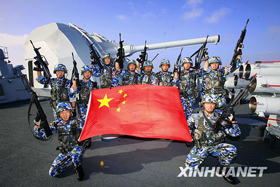When Dai Mingmeng took off from and landed on an aircraft carrier on November 23, 2012, he became the first Chinese pilot to do so, and attracted the attention of both experts and the general public. Some observers called the event the turning point in China's aircraft carrier program. Others believe the November test's importance has been exaggerated, since it cannot meaningfully affect regional stability. But in reality, the takeoff and landing mark another of many stages China has completed on the way to becoming a full-fledged naval power. The future of the aircraft carrier segment of the fleet will depend primarily on the niche it comes to occupy in Beijing's military and political strategy.
From the Melbourne to the Nimitz?
It was back in 1928 that Chen Shaokuan, the then Navy Minister, suggested allocating 20 million renminbi to build the first Chinese aircraft carrier. But the plan never left paper. Later, Chinese military and political leaders repeated the attempt several times with the same result.
The first practical steps toward aircraft carrier construction were made in 1982-1988 by Admiral Liu Huaqing, the Navy Commander of the People's Liberation Army of China (PLA), considered to be the father of the country's modern navy. As Deputy Chief of Navy Staff in 1970, he launched an aircraft carrier construction feasibility study. In 1985, Australia sold China its Melbourne carrier to be scrapped, offering Chinese sailors and shipbuilders a unique chance to examine the ship and revitalize the national navy program.
After the Soviet Union's collapse, Beijing bought the decommissioned Kiev and Minsk Project 1143 carriers from Russia, as well as the incomplete Project 11436 carrier Varyag. Upgraded at the Dalian shipyard, the Varyag was renamed to the Liaoning, and became the first Chinese aircraft carrier to undergo sea trials in August 2011.
At the same time, China was working on sea-based aviation. In 2001, it purchased a Ukrainian T-10K-3 airplane, a prototype the of Soviet SU-33 naval fighter, and used it as the basis for creation of its own fighter model. In August 2009, the J-15 fighter made its maiden flight, while the J-15S two-seater took off in November 2012.
Data on the program's status are inconsistent. Some believe that by the mid-2020s the Chinese Navy plans to have up to four original carriers, including two conventionally powered Project 089 ships similar to the Liaoning, and two larger Project 085 vessels. Such a program would require significant investments, the concentration of numerous skilled personnel, and the solution of a myriad complex technical problems.
The construction of sufficient surface-to-air missile-equipped destroyers and logistics ships, the creation of appropriate infrastructure, and the training of a sufficient number of sailors and carrier aircraft pilots are among the most significant issues which would need to be addressed. Should the Chinese elect to build multi-purpose nuclear carriers comparable to the U.S. Nimitz, they would have to create decks of early-warning aircraft and catapults, as well as to select appropriate nuclear reactors.
China seeks to overtake South Korea in the global shipbuilding competition, having taken 29 percent of new orders and 39 percent of vessels constructed in 2011. Beijing's achievements in this area are impressive: among other things, the development of the Project 052C modern surface-to-air destroyer and the construction of the Project 095 third-generation multi-purpose nuclear submarines are proceeding smoothly even in the face of a variety of technical difficulties with the latter.
With the Chinese military budget growing by almost 12 percent annually, the U.S. Department of Defense believes that China's overall defense expenditures considerably exceed the official 90 billion dollars, and are reaching 120-180 billion dollars. Military acquisition expenses are thought to make up one third of the defense budget, with the Navy's share tentatively estimated at 20-30 percent, i.e. somewhere between 8 and 18 billion dollars.
The cost of building a strike group with a carrier similar to the Liaoning, with a full set of aircraft and escort ships, adds up to approximately 10 billion dollars. Hence, the construction of four such groups over 12 years will cost about 3.5 billion a year. Should defense spending maintain its current growth rate, the PLA Navy's plans seem quite realistic.
Warring without Fighting
Chinese leaders have repeatedly said that the Liaoning will be used only for testing and training purposes. While one may be skeptical of these statements, the creation of a full-blown strike group headed by the Liaoning would take at least five years. This is the minimum time to fcomplete the design and construction of enough sea-based aircraft and helicopters, to train sailors and pilots, and to ensure the development of teamwork between the ships. Even then, with the Liaoning as the group's flagship, the combat-ready strike group would not pose a serious military threat to the U.S. Navy, China's main rival in the global ocean.
It must be understood that the potential implementation of Chinese plans to break through the first island chain does not require a strike group. Even James Kraska's apocalyptic scenario assigns the Chinese carriers a secondary role, whereas the real threat to U.S. sea power comes from the anti-access/area denial systems, i.e. cruise and ballistic anti-ship missiles, non-nuclear submarines, mines etc.
At the same time, even two or three strike groups with Liaoning-class carriers will not be enough to confront the U.S.A. in open waters. The qualitative superiority of American carriers, sea-based aviation and submarines, as well as of deck aircraft experience, would make the Chinese strike groups easy prey. This is why Admiral Robert Willard, ex-Commander of U.S. Pacific Fleet, regards the Chinese carrier threat as purely symbolic. The Liaoning and similar carriers will have no early warning aircraft and will substantially limited in maximum take-off mass, which would curtail their capabilities in terms of naval supremacy and power projection for coastal operations compared to U.S. super-carriers.
In a naval confrontation with practically any state except the U.S.A., carriers could give China a significant advantage, which makes many Asia Pacific countries concerned about the Chinese carrier program. In a conflict with an equal or weaker rival, Chinese carriers would likely concentrate on air defense power so as to allow other ships to efficiently employ missiles against surface and coastal targets.
Chinese carriers might also conduct swift limited-scale operations with narrow political and military aims. A fait accompli policy in local conflicts may help China gain relatively quick victories, reach political goals and avoid interference by third parties. But most likely Beijing would resort to carriers to attain political ends without actual military collisions.
Due to the U.S. defense budget cuts and Washington's unwillingness to confront Beijing in earnest, carriers may generate significant political pressure on Taiwan and other countries disputing territories with China in the South China Sea and East China Sea. Past a certain point, Chinese power may reach a level when any attempt to retain balance will be doomed to failure, or involve expenses that would compel countries to concede.
However, this policy may result in dire consequences for Beijing. In view of the poor experience of relations with China in 1970-1980s, Vietnam is worried by rising Chinese naval power and ambitions, and is actively buying naval equipment from Russia and reinforcing links with India and the U.S.A..
Carriers may be also employed in situations that do not amount to a zero sum game, for example as a tool to strengthen China's international stance via naval diplomacy, as well as to create new intergovernmental links in the military-technical and military political fields bolster existing ones. As seen from U.S. naval experience, carriers are effective tools for humanitarian aid and aiding recovery from natural disasters. Since almost 65 million Chinese people travel and work outside their homeland, carriers may become indispensable for evacuation from countries undergoing a military or some other calamity.
In addition, a combat-ready carrier on patrol will vividly demonstrate China's economic, military and technological might both internationally and to the domestic audience, improving the Chinese Communist Party's image at the grass-root level and fostering patriotism. These are weighty reeasons to proceed with construction,, and make it entirely credible that the nascent carrier fleet will mainly be used for peacetime purposes.







